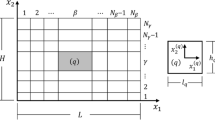Abstract
The problem of analyzing the stress-strain state (SSS) of structures is most frequently solved using finite elements in displacements. Combined elements do not always possess sufficient accuracy, however, as applies to shell structures. Equilibrium elements based on the principle of a minimum of additional energy and approximations of the stress fields exhibit good accuracy, and, as Gallagher [1] has indicated, are extremely promising. These same methods of combined and equilibrium elements has not, however, found broad development and application due to difficulties in its implementation. A limited number of studies [1–6] are focused, as a rule, on plates under an external load. The purpose of this paper is to refine the equilibrium-element method and develop it for other types of effects. The efficiency of the method is illustrated by calculations of bendable plate.
Similar content being viewed by others
References
R. Gallagher, Finite-Element Method. Fundamentals [Russian translation], Mir, Moscow (1984).
S. A. Kalanta, "Method of equilibrium finite elements in the mechanics of elastic deformable systems. System of solving equations," Mat. Modeli Algorit. Zadach Prikl. Mekh., No. 19, 42–54 (1978).
S. A. Kalanta, "Method of equilibrium finite elements in the mechanics of elastic deformable systems. Method of forces and method of displacements," Optimiz. Stroit. Mekh.,20 35–44 (1979).
M. D. Nikol'skii, "FEM shapes based on the Castilano principle," Stroit. Mekh. Raschet Sooruzh., No. 1, 23–28 (1983).
D. J. Olman, "Triangular finite elements for calculation of bendable plates with constant and linear distribution of bending moments," in: Computer-Aided Design of Elastic Structures [Russian translation], Vol. 1, Leningrad (1974), pp. 81–101.
G. Sander, "Application of the principle of dual analysis," in: Computer-Aided Design of Elastic Structures [Russian translation], Vol. 1, Leningrad (1974), pp. 120–150.
J. H. Argyris, I. Fried, and D. Schrapf, "The TUBA family of plate elements for the matrix displacement method," Aero. J.,72 701–709 (1968).
J. Bron and G. Dhatt, "Mixed quadrilateral elements for bending," Am. Inst. Aero. Astron. J.,10 No. 10, 1359–1361 (1972).
G. R. Cowper, E. Kosko, G. Lindberg, and M. Olson, "Static and dynamic applications of a high precision plate bending element," Am. Inst. Aeron. Astron. J.,7 No. 10, 1957–1965 (1969).
J. W. Harvey and S. Kelsey, "Triangular plate bending elements with enforced compatibility," Am. Inst. Aeron. Astron. J.,9 1023–1026 (1971).
B. A. Irons, "Conforming quartic triangular element for plate bending,", Int. J. Num. Meth. Eng.,1 No. 1, 29–46 (1969).
Additional information
Vilnius Technical Institute (Lithuania). Translated from Prikladnaya Mekhanika, Vol. 30, No. 2, pp. 77–83, February, 1984.
Rights and permissions
About this article
Cite this article
Kalanta, S.A. One variant of the finite-element method in elasicity theory. Int Appl Mech 30, 148–152 (1994). https://doi.org/10.1007/BF00848514
Received:
Issue Date:
DOI: https://doi.org/10.1007/BF00848514




